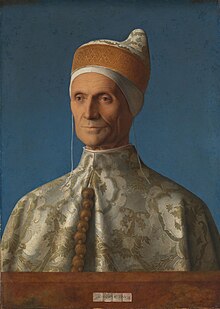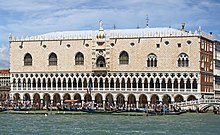User:Jp20law/Doge
The Doge[edit]
The office of dogeship was considered a quasi-sacral office, where the doge represented more than just himself.[1] Venetians perceived that God preferred their city, believing that the doge possessed a divine and temporal authority similar to that of the Catholic Pope in Rome.[2] In fact, the establishment of the office of dogeship contributed to the Myth of Venice, serving as an intermediary between Venetian citizens and the supernatural forces of heaven.[3][4] To differentiate himself from other doges, the doge of Venice was given the title il Principe. Such a title was courtesy and symbolic, where the doge could assert his superiority to neighboring European rulers and even the Pope himself.[5] The doge would be recognized as the highest officer of the republic and a symbol of Venetian sovereignty who would lead Venice for more than 1,000 years.[6][7]

The Doge's Palace[edit]
In Venice, the Doge lived in the Doge’s Palace (also known as the Palazzo Ducale), which was recognized as a visible expression of the idea of Venice.[8] The Palace was built at a time when republican governments were in power in most of the states of Italy.[9] During the thirteenth and fourteenth centuries, major Italian cities on the peninsula constructed civic palaces.[9] Because of its stark contrasts with other civic palaces, the Doge’s Palace became a “bold symbol” of Venetian prosperity and political power during the republic’s rise in the fourteenth and fifteenth centuries.[10]
Much of the effect of the Palace derives from its architecture.[9] Known as the “central building of the world,” the Palace was designed to be accessible and open to everyone, featuring three different architectural styles: the Classical, Islamic, and Gothic.[11][8] The Palace’s openness sets the building apart from other communal Italian spaces.[10] While the architecture of other Italian states seemed more defensive and effectively a fortress, the public can wander freely in the lower portico in the Palace.[10] Even the rooftop crenellations (battlements of a castle) seem more decorative rather than defensive.[10]

On the inside, oil paintings and compartmented ceilings dominated. One of the most prominent paintings included Paolo Veronese’s Triumph of Venice (1583). The Palace also contained the Great Council Hall where the doge would be elected by forty-one men perceived as “the most experienced, worthy and important of the city.”[12]
After being commissioned by Doge Marco Barbarigo in 1485 and finished by his brother, Agostino, a new staircase was built, known as the Scala dei Giganti.[13] The staircase became the final destination of a three-phase ritual during the coronation of the Doge of Venice.[14] In the first phase, the doge was presented to the citizenry in San Marco, where he then moved to the high altar and was given the vexillum of St. Mark, a “mystical source” of ducal authority.”[15] Afterwards, sailors carried the doge, tossing coins into the crowd to create a symbolic display of ducal largess.[15] Finally, these sailors carried the doge into a shaded passageway toward the Scala dei Giganti.[16] After reaching the top of the staircase, he took the oath of office and was crowned with the camauro and a zoia (corno ducale), a symbol representing the doge’s supreme political authority over Venice.[16]


- ^ Brown, Patricia (2005). Art and Life in Renaissance Venice (Reprint ed.). Pearson. p. 76. ISBN 9780131344020.
- ^ Humfrey, Peter (1997). Painting in Renaissance Venice. New Haven, CT: Yale University Press. p. 24. ISBN 9780300067156.
- ^ Muir, Edward (1979). "Images of Power: Art and Pageantry in Renaissance Venice". The American Historical Review. 84 (1): 25–26 – via JSTOR.
- ^ Brown, Patricia (2005). Art and Life in Renaissance Venice (Reprint ed.). Pearson. p. 78. ISBN 9780131344020.
- ^ Brown, Patricia (2005). Art and Life in Renaissance Venice (Reprint ed.). Pearson. p. 77. ISBN 9780131344020.
- ^ "Doge | Renaissance Italy, Republic of Venice, Maritime Republics | Britannica". www.britannica.com. Retrieved 2023-11-26.
- ^ Rosand, David (1997). Painting in Sixteenth-Century Venice: Titian, Veronese, Tintoretto (2nd ed.). Cambridge University Press. p. 1. ISBN 9780521565684.
- ^ a b Brown, Patricia (2005). Art and Life in Renaissance Venice (Reprint ed.). Pearson. pp. 65, 67. ISBN 9780131344020.
- ^ a b c Howard, Deborah (2004). The Architectural History of Venice (Revised, Enlarged ed.). New Haven, CT: Yale University Press. p. 83. ISBN 9780300090291.
- ^ a b c d Howard, Deborah (2004). The Architectural History of Venice (Revised, Enlarged ed.). Yale University Press. p. 85. ISBN 9780300090291.
- ^ Howard, Deborah (2004). The Architectural History of Venice (Revised, Enlarged ed.). New Haven, CT: Yale University Press. p. 79. ISBN 9780300090291.
- ^ Brown, Patricia (2005). Art and Life in Renaissance Venice (Reprint ed.). Pearson. p. 67. ISBN 9780131344020.
- ^ Muir, Edward (1979). "Images of Power: Art and Pageantry in Renaissance Venice". The American Historical Review. 84 (1): 27 – via JSTOR.
- ^ Brown, Patricia (2005). Art and Life in Renaissance Venice (Reprint ed.). Pearson. pp. 85–86. ISBN 9780131344020.
- ^ a b Brown, Patricia (2005). Art and Life in Renaissance Venice (Reprint ed.). Pearson. p. 87. ISBN 9780131344020.
- ^ a b Brown, Patricia (2005). Art and Life in Renaissance Venice (Reprint ed.). Pearson. p. 88. ISBN 9780131344020.
